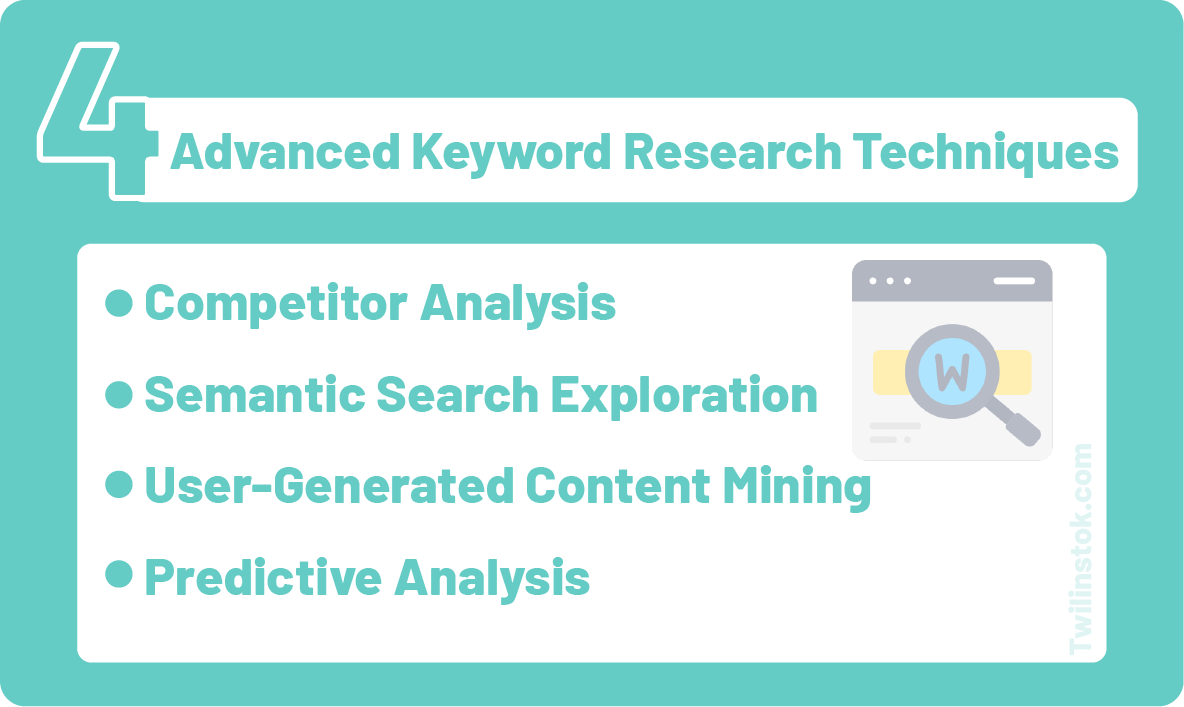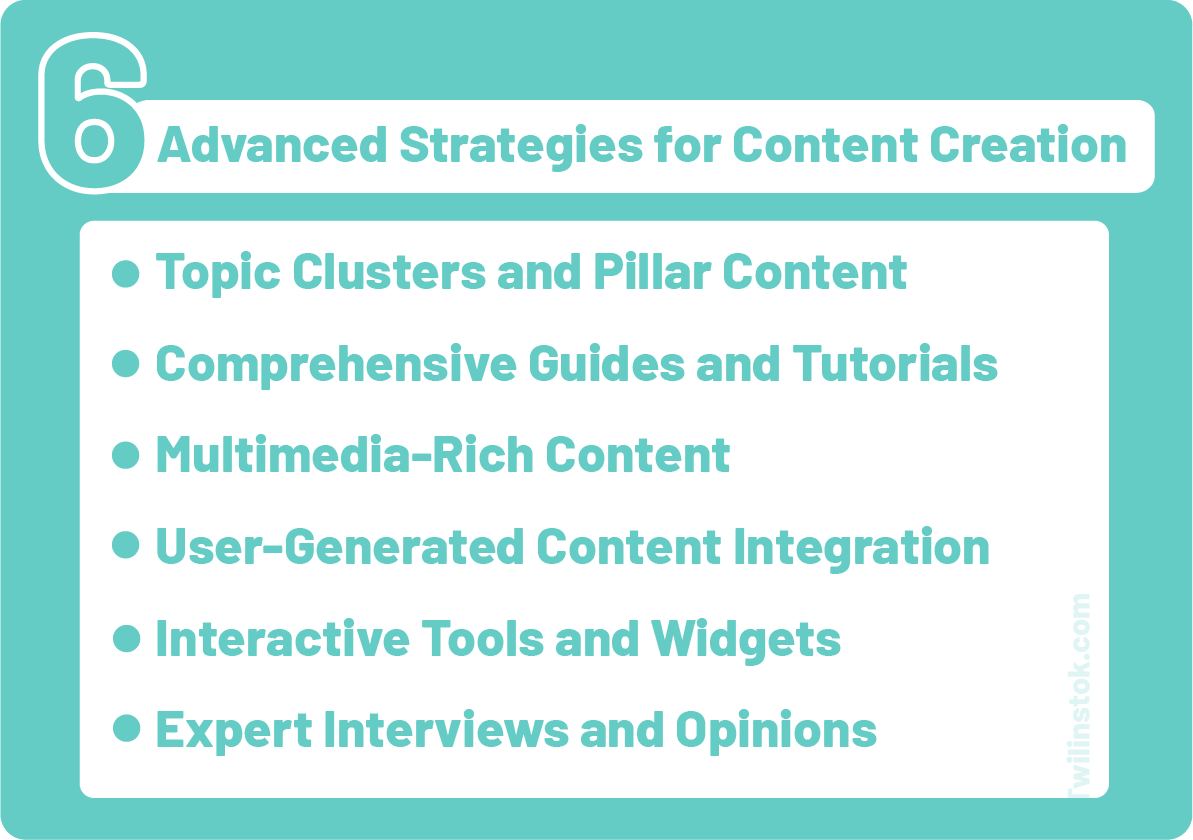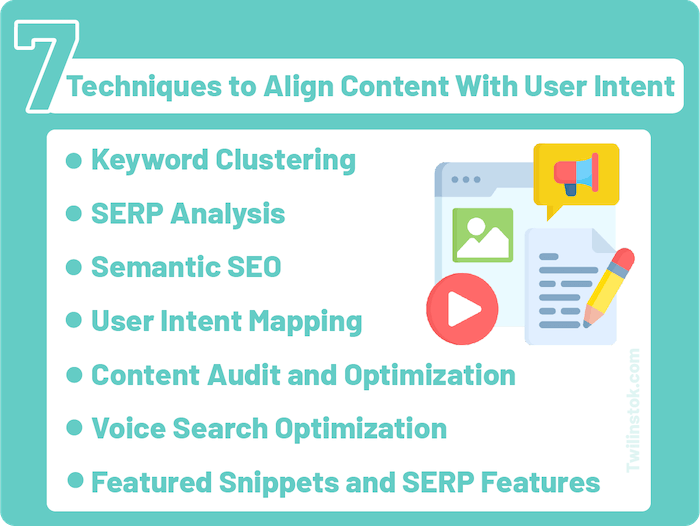In the vast landscape of SEO, mastering Advanced Long-Tail Keyword Targeting Strategies has become the cornerstone of online success. As search engines evolve and users seek more precise answers, understanding how to refine your approach is paramount. In this comprehensive guide from Twilinstok, we will decode the intricacies of Advanced Long-Tail Keyword Targeting Strategies and unveil the tactics that will set you on a path to SEO excellence.
Refining Long-Tail Keyword Strategies for User Intent Optimization
Why are you here? You’re not just looking for basic tips; you’re seeking advanced insights. We’ll uncover the reasons behind the pursuit of advanced long-tail keyword targeting and why it matters in today’s SEO landscape.
In the world of advanced SEO, understanding the user’s intent is paramount. While you may already be familiar with long-tail keywords and their importance, you’re seeking a deeper level of comprehension. You’re here to refine your strategy, enhance your skills, and stay ahead of the competition.
So, why refine your long-tail keyword strategies? The answer lies in achieving a competitive advantage, unlocking new opportunities, and driving superior results. Advanced long-tail keyword targeting allows you to tap into niches, answer specific user queries, and maximize the impact of your SEO efforts.
Exploring Advanced Long-Tail Keyword Targeting Strategies & Techniques for SEO Excellence
You’ve moved beyond the beginner stage. We’ll explore sophisticated techniques for uncovering those hidden gems in the world of long-tail keywords, providing you with a competitive edge.
While basic keyword research involves identifying relevant terms and assessing their search volume, advanced research takes a more nuanced approach. Here, you’re not merely looking for keywords; you’re uncovering insights.
Advanced keyword research techniques include:
- Competitor analysis
- Semantic search exploration
- User-generated content mining
- Predictive analysis
Now, let’s check each one.

Competitor Analysis
In advanced keyword research, competitor analysis goes beyond simply identifying keywords your competitors rank for. It involves dissecting their content strategies, uncovering gaps, and identifying opportunities they might have missed.
Example: Suppose you’re in the fitness industry, and a competitor ranks for “best home workout routines.” Rather than targeting the exact same keyword, you might identify a related, untapped opportunity like “innovative home workout equipment.”
Semantic Search Exploration
Semantic search explores the context and relationships between words, helping you uncover hidden long-tail keyword opportunities.
Example: If you’re in the technology niche, instead of just targeting “smartphone reviews,” you might delve into semantically related terms like “top-rated mobile devices for photography enthusiasts.”
User-Generated Content Mining
User-generated content provides a goldmine of real-world language that users use to search. Advanced UGC mining helps you tap into this resource effectively.
Example: Analyzing forums, you notice users commonly ask questions like “What’s the best budget laptop for graphic design?” This phrase becomes an advanced long-tail keyword target.
Predictive Analysis
Predictive analysis involves using data and algorithms to forecast emerging trends and keywords in your industry.
Example: In the finance sector, predictive analysis may reveal upcoming trends in cryptocurrency investment. You can then create content optimized for these emerging keywords.
These advanced methods allow you to unearth long-tail keywords that others may overlook, giving you a substantial advantage.
Mastering Content Creation for Long-Tail Keywords: Strategies and Examples
Content is still king, but at this level, we’re talking about mastery. Discover how to craft not just good but exceptional content tailored specifically for advanced long-tail keywords.
Creating content for long-tail keywords goes beyond mere optimization. It’s about providing in-depth, valuable information that precisely matches the user’s query. Here are some advanced strategies for content creation:
- Topic clusters and pillar content
- Comprehensive guides and tutorials
- Multimedia-rich content
- User-generated content integration
- Interactive tools and widgets
- Expert interviews and opinions
Now, let’s check each one.

Topic Clusters and Pillar Content
Advanced content creation involves building topic clusters around a pillar content piece. For instance, if your pillar content is about “digital marketing strategies,” the subtopics could be “social media marketing,” “content marketing,” and “SEO techniques.”
Example: Create an in-depth guide on “Digital Marketing Strategies” as your pillar content. Then, develop separate articles for each subtopic, such as “Advanced Social Media Marketing Tactics,” “Effective Content Marketing in 2023,” and “Mastering SEO Techniques for Higher Rankings.”
Comprehensive Guides and Tutorials
Long-tail keywords often indicate specific user intent. Create comprehensive guides and tutorials that thoroughly address the user’s query.
Example: If your long-tail keyword is “how to grow organic vegetables in small spaces,” produce a step-by-step guide covering soil preparation, plant selection, and maintenance techniques, complete with images or videos.
Multimedia-Rich Content
Enhance user engagement and understanding by incorporating multimedia elements like videos, infographics, and interactive content.
Example: For a long-tail keyword like “DIY home plumbing repair,” you could create a video tutorial demonstrating common plumbing fixes, accompanied by a detailed written guide and relevant infographics.
User-Generated Content Integration
Leverage user-generated content such as reviews, testimonials, and case studies to enhance credibility and provide real-world examples.
Example: If your long-tail keyword is “best budget DSLR cameras for beginners,” include user-generated reviews and testimonials alongside your expert analysis and recommendations.
Interactive Tools and Widgets
For complex long-tail queries, consider developing interactive tools or widgets that offer personalized solutions.
Example: If the keyword is “retirement savings calculator for freelancers,” create a user-friendly calculator tool that allows freelancers to input their financial data and receive tailored retirement savings plans.
Expert Interviews and Opinions
Provide additional value by interviewing industry experts or offering your expert opinion on niche-specific long-tail topics.
Example: If your long-tail keyword is “challenges in sustainable fashion,” interview renowned fashion designers or sustainability experts to provide insightful perspectives within your content.
These advanced content creation strategies cater to the specificity of long-tail keywords, offering valuable, in-depth information that satisfies user intent and positions your content as an authoritative resource.

Enhancing Click-Through Rates with Advanced Meta Tag and Description Optimization
Clicks matter. We’ll delve into advanced strategies for optimizing your meta tags and descriptions, ensuring you get the clicks you deserve.
Meta tags and descriptions are your first opportunity to entice users and earn their clicks. In advanced SEO, crafting compelling meta content goes beyond mere keyword inclusion. It involves:
- Engaging Titles: Create titles that not only contain your target keyword but also pique curiosity, provide solutions, or offer unique value propositions.
- Descriptive Descriptions: Craft meta descriptions that provide a glimpse of what users will find on your page, emphasizing the benefits of clicking through.
- Rich Snippets: Implement structured data markup to enable rich snippets in search results, enhancing visibility and click-through rates.
- A/B Testing: Continuously test and refine your meta content to identify what resonates best with your audience.
- Mobile Optimization: Ensure that your meta content is optimized for mobile devices, where an increasing number of searches occur.
By optimizing your meta tags and descriptions, you increase the likelihood of users clicking through to your content, a crucial factor in SEO success.
Aligning Content with User Intent: Crafting Highly Relevant Pages with Long-Tail Keywords
User intent is the name of the game. Learn how to take your content alignment to an advanced level, delivering exactly what users are searching for.
Understanding user intent is essential in advanced SEO. It involves analyzing search queries to discern the underlying motivations of users. To align your content with user intent:
- Segmented Content: Create content that caters to different stages of the user’s journey. For instance, informational content for those in the research phase and transactional content for those ready to make a purchase.
- Intent Analysis Tools: Utilize advanced tools that analyze search queries and provide insights into user intent, helping you tailor your content accordingly.
- SERP Analysis: Study the search engine results pages (SERPs) for your target keyword to understand what type of content Google deems relevant for that query.
- Natural Language Processing: Leverage advanced natural language processing (NLP) algorithms to better understand user queries and craft content that precisely matches them.
By aligning your content with user intent, you create highly relevant pages that satisfy users’ needs and preferences. Let’s explore how to align content with user intent, providing concrete examples:
- Keyword clustering
- SERP analysis
- Semantic SEO
- User intent mapping
- Content audit and optimization
- Voice search optimization
- Featured snippets and SERP features
Now let’s check these tricks.

Keyword Clustering
Advanced SEO involves grouping related long-tail keywords into clusters and crafting content that addresses the overarching theme.
Example: Suppose your keyword cluster revolves around “healthy vegetarian recipes.” You can create content like “Quick Vegetarian Breakfast Ideas” and “Nutrient-Rich Vegetarian Dinner Recipes” to align with specific user search intents.
SERP Analysis
Analyze search engine results pages (SERPs) to understand the type of content that ranks well for specific long-tail keywords.
Example: If you’re targeting the keyword “best hiking trails in California,” examine the SERPs to find that users are looking for detailed trail descriptions, difficulty levels, and photos. Craft your content to match these user expectations.
Semantic SEO
Implement semantic SEO techniques to incorporate related terms and entities, enhancing content relevance.
Example: When writing about “smart home automation,” include semantically related terms like “IoT devices,” “voice assistants,” and “home security” to align with the broader user intent for smart home information.
User Intent Mapping
Map user intent throughout the customer journey, from awareness to consideration and conversion.
Example: If your long-tail keyword is “best budget DSLR cameras,” create content that addresses different stages of the buying process, from explaining camera basics to comparing budget options and providing purchase guidance.
Content Audit and Optimization
Regularly audit and optimize existing content to ensure it aligns with evolving user intent and search trends.
Example: If you have an article on “healthy vegan diets” that used to perform well but is now outdated, refresh it with the latest research, recipes, and tips to align with the current user intent for vegan nutrition.
Voice Search Optimization
Recognize the growing significance of voice search and tailor content to answer voice queries concisely.
Example: Optimize your content for voice search by providing succinct answers to questions like “What are the best running trails near me?” to align with the voice search user intent.
Featured Snippets and SERP Features
Craft content that targets featured snippets and rich SERP features by addressing common user queries directly.
Example: For the long-tail keyword “how to change a flat tire,” structure your content with clear, step-by-step instructions to increase the chances of earning a featured snippet.
By aligning content with user intent through these advanced strategies, you create highly relevant pages that not only satisfy users’ needs but also boost your chances of ranking prominently in search results.

Leveraging User-Generated Content: Strategies to Empower Your Audience
User-generated content isn’t just for beginners. We’ll explore advanced tactics to harness the full potential of user-generated content for long-tail keyword targeting.
User-generated content (UGC) is a valuable resource in advanced SEO. It includes reviews, comments, forum discussions, and social media posts generated by your audience. Here’s how to leverage UGC effectively:
- UGC Mining Tools: Employ advanced UGC mining tools to collect and analyze user-generated content related to your niche.
- Content Amplification: Use UGC to amplify your content by showcasing user reviews, testimonials, and success stories on your website.
- Community Engagement: Build an engaged online community around your brand, encouraging users to contribute valuable content.
- UGC-Driven Insights: Extract insights from user-generated content to identify emerging trends, pain points, and keywords.
User-generated content not only enhances your SEO efforts but also fosters a sense of community and trust around your brand.
Measuring Advanced Performance Metrics: Data-Driven SEO Strategies
Numbers tell the story. We’ll dive into advanced data analysis and measurement techniques to ensure your advanced long-tail keyword strategies are paying off.
In advanced SEO, data becomes your compass. You need to measure the effectiveness of your strategies and make data-driven decisions. Advanced SEO metrics to consider include:
- Conversion Rates: Analyze conversion rates for specific long-tail keywords to identify high-performing phrases.
- Bounce Rates: Evaluate bounce rates to gauge the relevance and engagement of your content.
- Click-Through Rates: Measure click-through rates for various long-tail keywords to assess their attractiveness to users.
- Ranking Progression: Track the progression of your rankings for long-tail keywords over time.
- Traffic Segmentation: Segment your website traffic to understand how different long-tail keywords contribute to overall performance.
By diving into the data, you can refine your strategy, allocate resources more effectively, and achieve advanced SEO success.
Exploring the Latest Trends in Long-Tail Keyword SEO
You’re not content with the status quo. Discover the latest trends and emerging techniques in the world of advanced long-tail keyword SEO.
In the fast-paced world of SEO, staying current is crucial. Advanced SEO professionals keep an eye on the latest trends, including:
- Voice Search Optimization: How voice search is changing the game for long-tail keywords. (For more information you can click on : Voice Search Optimization Techniques)
- BERT and Natural Language Processing: The impact of Google’s BERT algorithm and NLP on search queries.
- Local SEO: How long-tail keywords play a vital role in local SEO strategies. (In This Regard: “Local SEO For Small Cafes”)
- Featured Snippets and SERP Features: Strategies for winning featured snippet positions.
- Mobile-First Indexing: Adapting your long-tail keyword strategy for mobile-first indexing.
Being aware of and adapting to these trends ensures you remain competitive in the ever-evolving SEO landscape.
Conclusion
As we conclude this journey through the world of SEO, armed with the knowledge of Advanced Long-Tail Keyword Targeting Strategies, you are well-prepared to elevate your online presence. Remember, SEO is a dynamic field, and staying at the forefront of innovation is key. By implementing the advanced strategies discussed here, you can confidently navigate the ever-evolving SEO landscape and secure a prominent place in search engine results. So, go forth and apply these Advanced Long-Tail Keyword Targeting Strategies to thrive in the digital realm.
For more information about Search Engine Optimization, we suggest that you click on Free SEO Tutorial [+]. Also, if you have any questions about SEO, you can ask them in our SEO support center [+] in the form of a topic and wait for the answer of our experts.
FAQs: Advanced Insights into Long-Tail Keyword SEO
How can I identify advanced long-tail keywords with low competition?
Utilize advanced keyword research tools, analyze competitor strategies, and focus on specific niches within your industry.
What advanced tools and techniques can help me analyze user intent effectively?
Advanced intent analysis tools, natural language processing (NLP), and studying SERPs for your target keywords can enhance user intent understanding.
Are there advanced content creation methods specifically tailored to long-tail keywords?
Yes, such as creating topic clusters, comprehensive guides, and multimedia-rich content aligned with user intent.
How can I implement advanced user-generated content strategies for SEO success?
Use advanced UGC mining tools, engage your community, and showcase user-generated content to amplify your SEO efforts.
What advanced metrics should I monitor to assess the performance of my long-tail keyword targeting efforts?
Monitor conversion rates, bounce rates, click-through rates, ranking progression, and traffic segmentation to measure the impact of your strategies.

